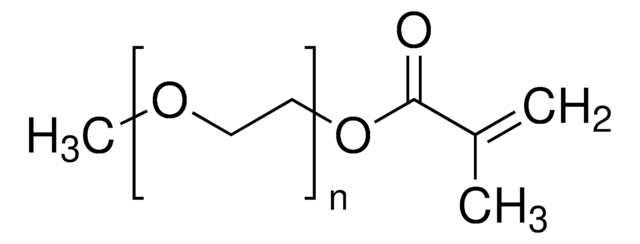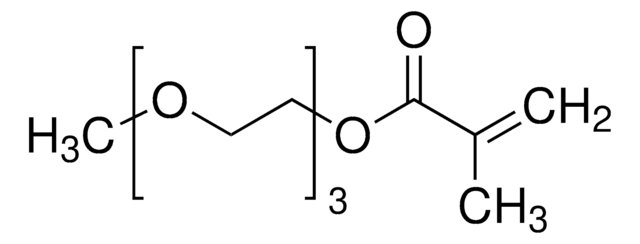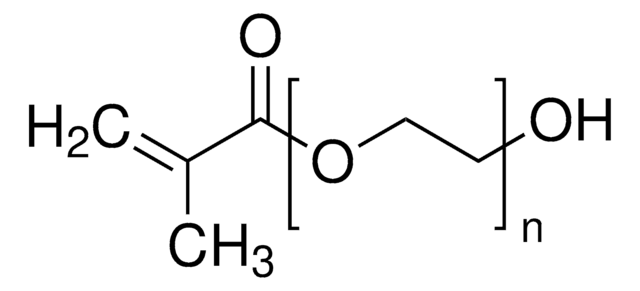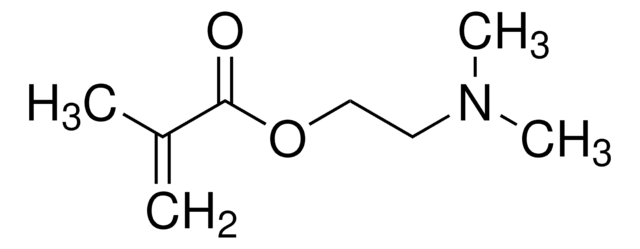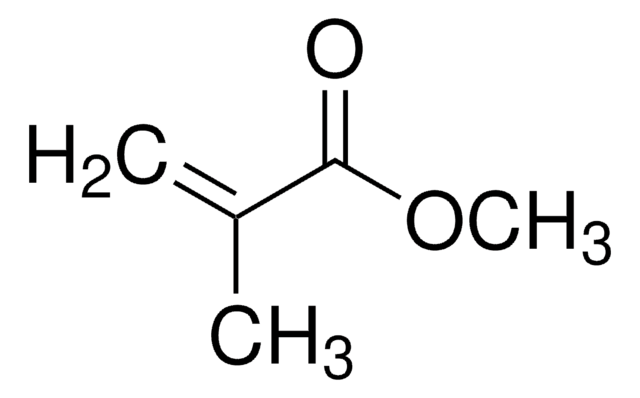415332
Ethylene glycol methyl ether methacrylate
99%
Synonym(s):
2-Methoxyethyl methacrylate
Sign Into View Organizational & Contract Pricing
All Photos(1)
About This Item
Linear Formula:
H2C=C(CH3)CO2CH2CH2OCH3
CAS Number:
Molecular Weight:
144.17
EC Number:
MDL number:
UNSPSC Code:
12162002
PubChem Substance ID:
NACRES:
NA.23
Recommended Products
Quality Level
Assay
99%
form
liquid
refractive index
n20/D 1.431 (lit.)
bp
65 °C/12 mmHg (lit.)
density
0.993 g/mL at 25 °C (lit.)
SMILES string
COCCOC(=O)C(C)=C
InChI
1S/C7H12O3/c1-6(2)7(8)10-5-4-9-3/h1,4-5H2,2-3H3
InChI key
YXYJVFYWCLAXHO-UHFFFAOYSA-N
General description
Polymers prepared from this monomer may have uses in polyelectrolytes and may be biocompatible.
Application
Used in the synthesis of copolymers of styrene and 2-methoxyethyl methacrylate.
Signal Word
Danger
Hazard Statements
Precautionary Statements
Hazard Classifications
Repr. 1B
Storage Class Code
6.1C - Combustible acute toxic Cat.3 / toxic compounds or compounds which causing chronic effects
WGK
WGK 1
Flash Point(F)
149.0 °F - closed cup
Flash Point(C)
65 °C - closed cup
Personal Protective Equipment
dust mask type N95 (US), Eyeshields, Gloves
Choose from one of the most recent versions:
Already Own This Product?
Find documentation for the products that you have recently purchased in the Document Library.
Separation of stat-copoly (styrene/2-methoxyethyl methacrylate) samples according to composition by gradient high-performance liquid chromatography.
Glockner G, et al.
Journal of Applied Polymer Science, 37(11), 3147-3161 (1989)
Priyanshi Agnihotri et al.
Soft matter, 16(33), 7845-7859 (2020-08-07)
Herein, we report synthesis of thermoresponsive poly(N-isopropylaccrylamide) (PNIPAM) microgels with short oligo(ethylene glycol) (OEG) chain comonomers (1 to 4/5 repeating unit) by surfactant-free precipitation copolymerization. The efficient incorporation of the comonomers was confirmed by a complete set of characterization methods
Caroline R Szczepanski et al.
European polymer journal, 67, 314-325 (2015-05-09)
This work presents an approach to extend the period for phase separation, independent of temperature, in ambient phase-separating photopolymerizations based on the copolymerization of structurally similar mono- and di-vinyl monomers. Copolymer resins composed of triethylene glycol dimethacrylate (TEGDMA) and ethylene
Vitalii Rosiuk et al.
Langmuir : the ACS journal of surfaces and colloids, 35(21), 7009-7017 (2019-05-14)
Nanoprecipitation is a straightforward yet powerful technique to synthesize polymer nanoparticles loaded with various biologically active compounds or contrast agents. Particle formation in this approach is kinetically controlled, and various assembly parameters have been used to control the size distribution
Our team of scientists has experience in all areas of research including Life Science, Material Science, Chemical Synthesis, Chromatography, Analytical and many others.
Contact Technical Service
